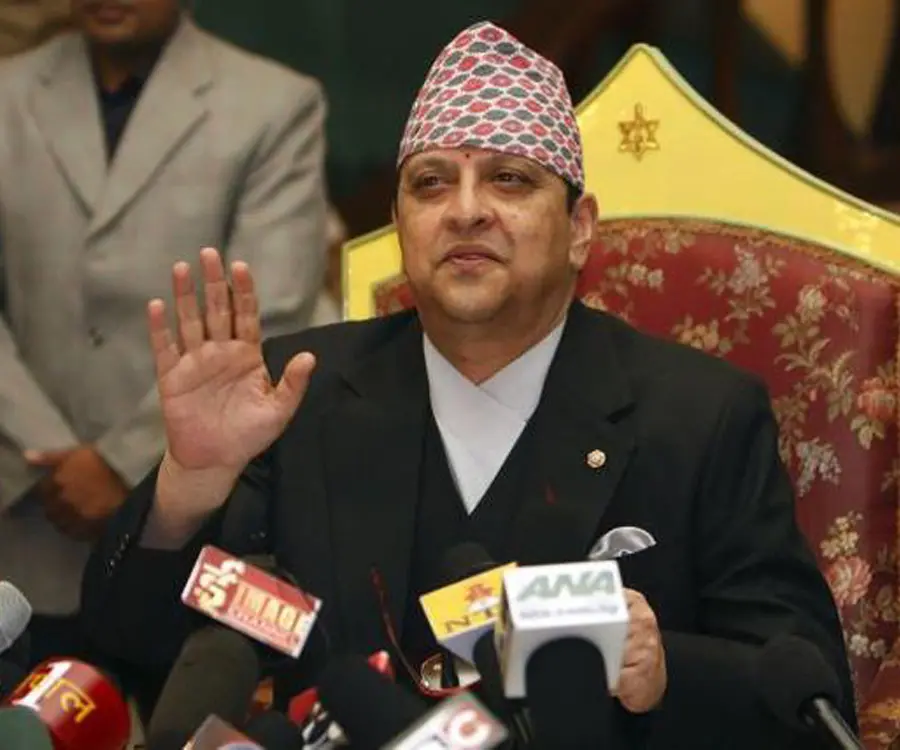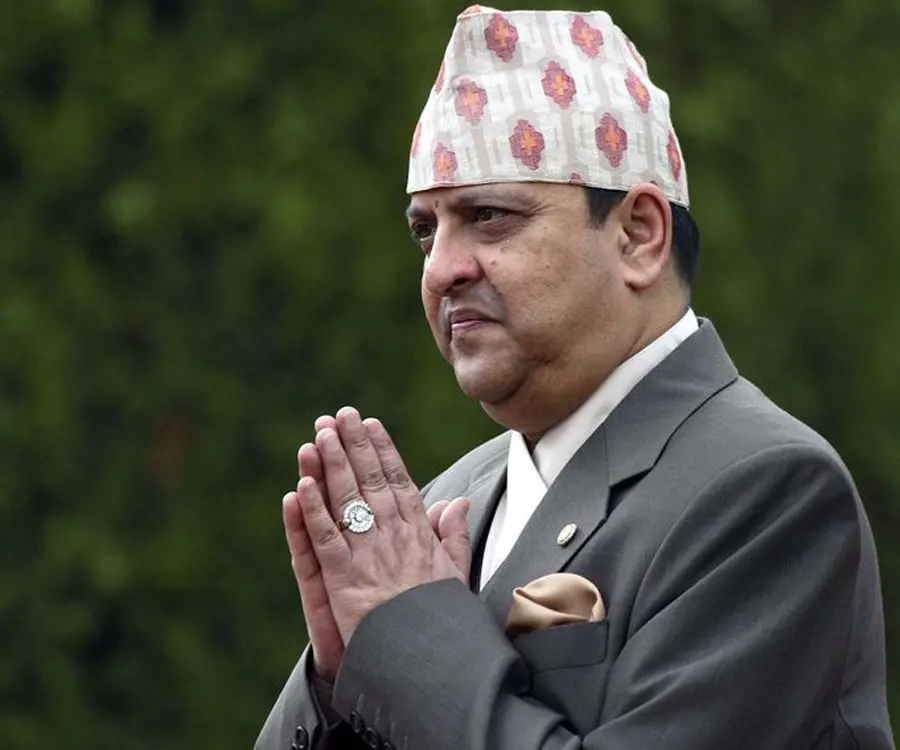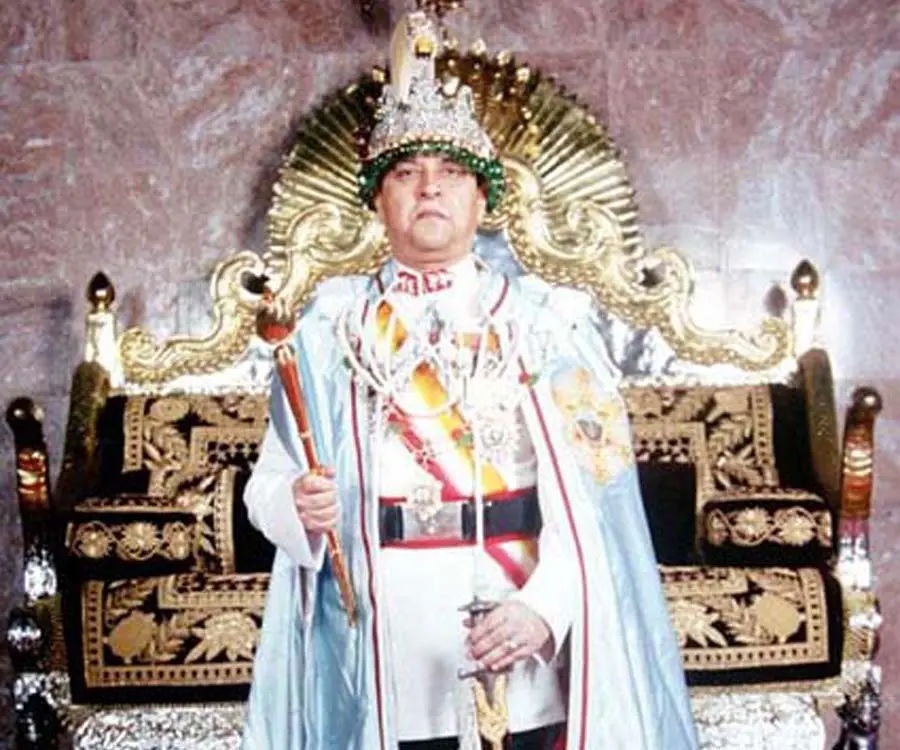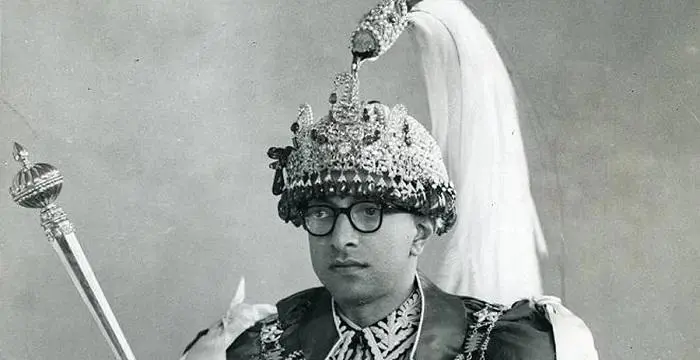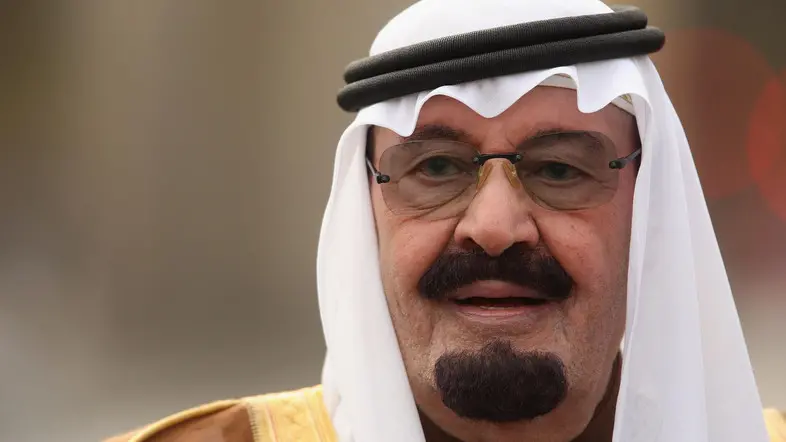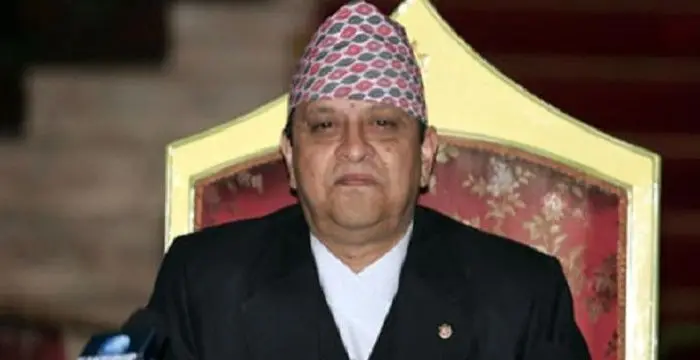
Gyanendra Bir Bikram Shah Dev - Nepalese Emperors, Timeline and Life
Gyanendra Bir Bikram Shah Dev's Personal Details
Gyanendra Bir Bikram Shah Dev was the king of Nepal from 2001 to 2008
| Information | Detail |
|---|---|
| Birthday | July 7, 1947 |
| Nationality | Nepali |
| Famous | Historical Personalities, Emperors & Kings, Emperors, Former King of Nepal, Kings, Nepalese Emperors |
| Spouses | Queen Komal of Nepal |
| Siblings | Birendra of Nepal |
| Known as | Gyanendra of Nepal |
| Childrens | Crown Prince of Nepal, Paras, Princess Prerana of Nepal |
| Universities |
|
| Birth Place | Narayanhity Royal Palace, Kathmandu, Nepal |
| Religion | Hinduism |
| Gender | Male |
| Father | Mahendra of Nepal |
| Mother | Indra Rajya Laxmi Devi Shah |
| Sun Sign | Cancer |
| Born in | Narayanhity Royal Palace, Kathmandu, Nepal |
| Famous as | Former King of Nepal |
Gyanendra Bir Bikram Shah Dev's photo
Who is Gyanendra Bir Bikram Shah Dev?
Gyanendra Bir Bikram Shah Dev was the king of Nepal from 2001 to 2008. He became the 12th king of Nepal after his elder brother King Birendra was assassinated in a shooting incident that killed most of his family members. Gyanendra was absent when the incident occurred at a dinner party held at the ‘Narayanhiti Royal Palace’ in Kathmandu. The eldest son of King Birendra Crown Prince Dipendra is said to have carried out the massacre and got grievously injured in the massacre which took place on June 1, 2001. Gyanendra became the King of Nepal after crown Prince Dipendra, died a few days later of gunshot wounds. Gyanedra’s rule was marked by a civil war which erupted between the government and Maoist guerilla forces led by Pushpa Kamal Dahal or Prachanda and Baburam Bhattarai The civil war lasted from 1996 to 2006. During this time he dissolved the parliament and took over the reins of the government into his own hands. After the cessation of hostilities he was forced to hold elections which were won by an alliance of seven political parties. He had to relinquish power when the parliament (comprising of the seven party alliance) abolished the monarchy and transformed it into a democratic republic.
// Famous Emperors
Sundiata Keita
Sundiata Keita was the founder of the Mali Empire in West Africa. This biography profiles his childhood, early life, struggles, founding of empire, rule, administration, achievements and also gives some fun facts.
Ashoka
Ashoka was the third emperor of the Mauryan Dynasty and ruled almost the entire Indian subcontinent. This biography profiles his childhood, life, reign, achievements and timeline
Murad IV
Murad IV was one of the mighty Sultans in the history of the Ottoman Empire. This biography profiles his childhood, family, accession, rule, administration and timeline.
Childhood & Early Life
Gyanendra was born on July 7, 1947 in the Narayanhiti Royal Palace in Kathmandu. He was the second son of Crown Prince Mahendra Bir Bikram Shah Dev and Crown Princess Indra Rajya Laxmi Devi.
He had an elder brother, Prince Birendra, two elder sisters, Princess Shanti and Princess Sharada, one younger brother, Prince Dhirendra and one younger sister, Princess Shobha.
He became the King of Nepal for the first time in November 1950 when King Tribhuvan and all of his royal family fled to India fearing a threat to their lives. He was left behind and being the only male member of the royal family in the country he was made the King of Nepal by the Prime Minister Mohan Shamsher who belonged to the Rana dynasty.
He gave up his monarchy to his grandfather King Tribhuvan in January 1951 when he returned to Nepal from exile after a deal was made between Nepal and India which opposed the rule of the Prime Ministers belonging to the Rana dynasty.
He did his initial schooling at the ‘St. Joseph’s College, Darjeeling in India. He graduated from the Tribhuvan University in Kathmandu in 1969.
Career
Gyanendra was the Chairman of the Advisory Committee which arranged the coronation ceremony of his elder brother King Birendra Bir Bikram Shah Dev held in 1975.
He was a conservation enthusiast and held the post of Chairman in the ‘King Mahendra Trust for Nature Conservation’ from 1982 till 2001 when he ascended the throne. The trust became known as the ‘National Trust for Nature Conservation’.
By 1999 a civil war between the government of King Birendra and the Maoist guerillas led by Prachanda broke out.
A great controversy still surrounds the massacre of the whole royal family in Nepal on June 1, 2001. When Prince Dipendra, the eldest son of King Birendra died of the bullet wounds received during the massacre on June 4 2001, King Gyanendra was sworn in as the King of Nepal.
In May 2002 he dismissed the parliament headed by Prime Minister Sher Bahadur Deuba which had been elected in 1999.
In October 2002 he dismissed Deuba and assumed full authority of running the country himself promising that normalcy will return within the next three years.
During the next three years from 2002 to 2005 he dismissed three more Prime Ministers for not being able to hold elections as the civil war was still continuing and again became the absolute ruler of Nepal on February 1, 2005.
He tried to reinstate the ‘Constitutional Monarchy’ which had been abolished by his elder brother King Birendra but was confronted with opposition from all political parties.
During these three years he resorted to repression and restricted civil liberties such as the freedom of the press, protection against censorship and preventive detention provided by the constitution.
Protests against this repression soon turned violent. When a curfew supported by teargas and firing claimed 23 lives, Gyanendra agreed to hand over the reins of the government to a prime minister chosen by the seven party alliance on April 21, 2006.
Girija Prasad Koirala was made the Prime Minister of the seven party alliance with the promise that King Gyanendra will have a say in the government.
After discussions with Koirala, King Gyanendra agreed to reinstate the parliament on April, 24, 2006.
The political parties did not honor this agreement made between Gyanendra and supported by the Indian government. On June 10, 2006 the parliament abolished all the powers of the king including veto powers. The Prime Minister gained the powers of the king according to the constitution.
The interim parliament was set up on January 15, 2007 and the interim government was formed on April 1, 2007.
The bill for the amendment of the 1990 constitution was passed on December 28, 2007 which transformed Nepal from a monarchy into a federal democratic republic.
All properties that King Gyanendra had except those that he had inherited before becoming king were confiscated and nationalized on August 23, 2007.
Personal Life & Legacy
Gyanendra married his second cousin Princess Komal Rajya Laxmi Devi on May 1, 1970 in Kathmandu.
They have two children, a son, Prince Paras and Princess Prerana from the marriage.
Trivia
At the time of his birth, his father, King Mahendra, did not look at Gyanendra as the court astrologer had told him that he would bring only bad luck.
// Famous Former King of Nepal
Mahendra Bir Bikram Shah Dev
Mahendra Bir Bikram Shah Dev was the King of Nepal from 1955 to 1972. This biography provides detailed information about his childhood, life, reign, achievements and timeline.
Gyanendra Bir Bikram Shah Dev biography timelines
- // 7th Jul 1947Gyanendra was born on July 7, 1947 in the Narayanhiti Royal Palace in Kathmandu. He was the second son of Crown Prince Mahendra Bir Bikram Shah Dev and Crown Princess Indra Rajya Laxmi Devi.
- // Nov 1950He became the King of Nepal for the first time in November 1950 when King Tribhuvan and all of his royal family fled to India fearing a threat to their lives. He was left behind and being the only male member of the royal family in the country he was made the King of Nepal by the Prime Minister Mohan Shamsher who belonged to the Rana dynasty.
- // Jan 1951He gave up his monarchy to his grandfather King Tribhuvan in January 1951 when he returned to Nepal from exile after a deal was made between Nepal and India which opposed the rule of the Prime Ministers belonging to the Rana dynasty.
- // 1969He did his initial schooling at the ‘St. Joseph’s College, Darjeeling in India. He graduated from the Tribhuvan University in Kathmandu in 1969.
- // 1st May 1970Gyanendra married his second cousin Princess Komal Rajya Laxmi Devi on May 1, 1970 in Kathmandu.
- // 1975Gyanendra was the Chairman of the Advisory Committee which arranged the coronation ceremony of his elder brother King Birendra Bir Bikram Shah Dev held in 1975.
- // 1982 To 2001He was a conservation enthusiast and held the post of Chairman in the ‘King Mahendra Trust for Nature Conservation’ from 1982 till 2001 when he ascended the throne. The trust became known as the ‘National Trust for Nature Conservation’.
- // 1990 To 28th Dec 2007The bill for the amendment of the 1990 constitution was passed on December 28, 2007 which transformed Nepal from a monarchy into a federal democratic republic.
- // 1999By 1999 a civil war between the government of King Birendra and the Maoist guerillas led by Prachanda broke out.
- // May 1999 To May 2002In May 2002 he dismissed the parliament headed by Prime Minister Sher Bahadur Deuba which had been elected in 1999.
- // 4th Jun 2001A great controversy still surrounds the massacre of the whole royal family in Nepal on June 1, 2001. When Prince Dipendra, the eldest son of King Birendra died of the bullet wounds received during the massacre on June 4 2001, King Gyanendra was sworn in as the King of Nepal.
- // Oct 2002In October 2002 he dismissed Deuba and assumed full authority of running the country himself promising that normalcy will return within the next three years.
- // 2006After discussions with Koirala, King Gyanendra agreed to reinstate the parliament on April, 24, 2006.
- // 21st Apr 2006Protests against this repression soon turned violent. When a curfew supported by teargas and firing claimed 23 lives, Gyanendra agreed to hand over the reins of the government to a prime minister chosen by the seven party alliance on April 21, 2006.
- // 10th Jun 2006The political parties did not honor this agreement made between Gyanendra and supported by the Indian government. On June 10, 2006 the parliament abolished all the powers of the king including veto powers. The Prime Minister gained the powers of the king according to the constitution.
- // 1st Apr 2007The interim parliament was set up on January 15, 2007 and the interim government was formed on April 1, 2007.
- // 23rd Aug 2007All properties that King Gyanendra had except those that he had inherited before becoming king were confiscated and nationalized on August 23, 2007.
// Famous Kings
Sundiata Keita
Sundiata Keita was the founder of the Mali Empire in West Africa. This biography profiles his childhood, early life, struggles, founding of empire, rule, administration, achievements and also gives some fun facts.
Ashoka
Ashoka was the third emperor of the Mauryan Dynasty and ruled almost the entire Indian subcontinent. This biography profiles his childhood, life, reign, achievements and timeline
Murad IV
Murad IV was one of the mighty Sultans in the history of the Ottoman Empire. This biography profiles his childhood, family, accession, rule, administration and timeline.
Xerxes I
Xerxes I (Xerxes the Great) was the fourth and the most famous king of the Archaemenid dynasty of Persia. This biography profiles his childhood, family, personal life, life history, achievements, campaigns, administration, death and other facts.
Sargon of Akkad
Sargon of Akkad, also called ‘Sargon the Great’, ‘Sarru-Kan’ and ‘Shar-Gani-Sharri’, was the founder and first king of the Akkadian Empire. This biography profiles his childhood, life, rule, administration, timeline, and gives some fun facts.
Abdullah of Saudi Arabia
Abdullah bin Abdulaziz Al Saud was the King of Saudi Arabia from 2005 to 2015 and the third wealthiest head of state in the world. Find more facts about his life, childhood and timeline.
Gyanendra Bir Bikram Shah Dev's FAQ
What is Gyanendra Bir Bikram Shah Dev birthday?
Gyanendra Bir Bikram Shah Dev was born at 1947-07-07
Where is Gyanendra Bir Bikram Shah Dev's birth place?
Gyanendra Bir Bikram Shah Dev was born in Narayanhity Royal Palace, Kathmandu, Nepal
What is Gyanendra Bir Bikram Shah Dev nationalities?
Gyanendra Bir Bikram Shah Dev's nationalities is Nepali
Who is Gyanendra Bir Bikram Shah Dev spouses?
Gyanendra Bir Bikram Shah Dev's spouses is Queen Komal of Nepal
Who is Gyanendra Bir Bikram Shah Dev siblings?
Gyanendra Bir Bikram Shah Dev's siblings is Birendra of Nepal
Who is Gyanendra Bir Bikram Shah Dev childrens?
Gyanendra Bir Bikram Shah Dev's childrens is Crown Prince of Nepal, Paras, Princess Prerana of Nepal
What was Gyanendra Bir Bikram Shah Dev universities?
Gyanendra Bir Bikram Shah Dev studied at Tribhuvan University
What is Gyanendra Bir Bikram Shah Dev's religion?
Gyanendra Bir Bikram Shah Dev's religion is Hinduism
Who is Gyanendra Bir Bikram Shah Dev's father?
Gyanendra Bir Bikram Shah Dev's father is Mahendra of Nepal
Who is Gyanendra Bir Bikram Shah Dev's mother?
Gyanendra Bir Bikram Shah Dev's mother is Indra Rajya Laxmi Devi Shah
What is Gyanendra Bir Bikram Shah Dev's sun sign?
Gyanendra Bir Bikram Shah Dev is Cancer
How famous is Gyanendra Bir Bikram Shah Dev?
Gyanendra Bir Bikram Shah Dev is famouse as Former King of Nepal
